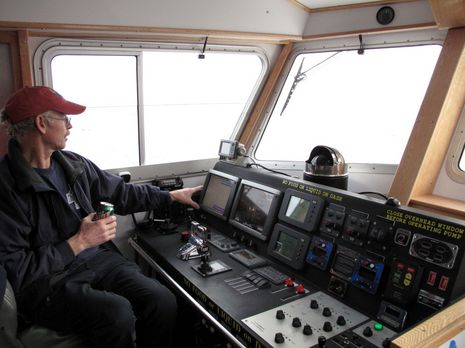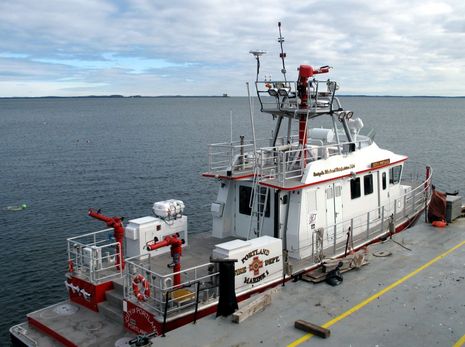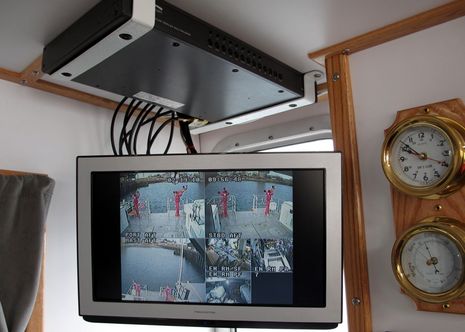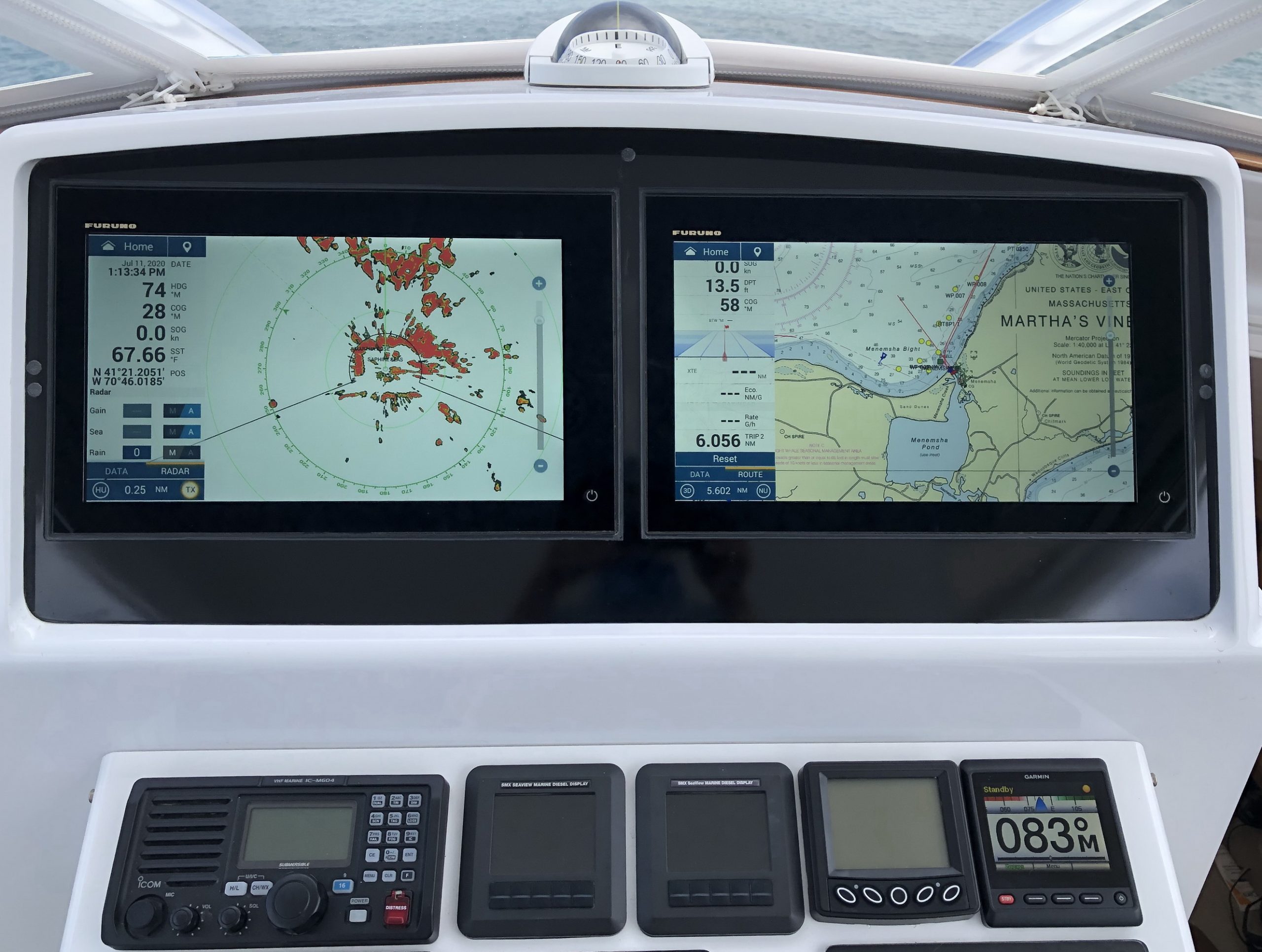Fire Boat “City of Portland” — wet & wired
This morning I managed to talk my way onto Portland’s new fire boat, City of Portland (IV), just before it headed home from Rockland Marine, and I was glad I did. Apparently the firemen themselves got to choose the electronics and they ended up with an interesting mix. Those are two Garmin GMR HD24 radar domes just forward of, and beneath, that remote-controlled 3,000 gallon-per-minute water cannon. It’s aimed to starboard like that because when its dedicated 525hp diesel pump fires up, it burps a “large dollop” of salt water before going full stream, and the crew are trying to give the domes a chance. Given that the canon can purportedly hole a building at close range, the fire fighters must also have a strategy (like rotation stops) to avoid blowing that Furuno satellite compass (upper left) into space…
Another thing you want on a boat with a monster water cannon on top — especially one which is manned 24/7 by rotating crews — is a clear reminder to close the overhead hatch before firing up the pump. If you click on the photo below, you’ll see it written clearly right above the firefighting station. Fireman David Crowely, sitting at the main helm in the shot below, explained that they’d chosen Garmin 5212s for similar reasons…because they felt them easiest to use for all the personnel cycling through. And they’re happy with their choice, except that he was a little bummed that the Furuno satellite compass at the top of the dash had recently stopped communicating with the Garmins (via NMEA 0183, I presume) so he didn’t have good heading and radar overlay when tied up. That’s a Raymarine 218 VHF and Furuno FA-150 AIS just forward of the electronic controls, and just to its right is a joystick for either of two big dual beam ColorLights. The boat also had a thermal camera, but it “hasn’t worked out” (brand unnamed) and they’re thinking about switching to a FLIR.

The boat also has seven monitoring cameras — all Raymarine 100’s, I think — going to a multiplexing and recording system just abaft the helm. And in addition to the helm shown above, there’s a complete backup helm to starboard, plus an open air one above (watch out for the canon!), and a maneuvering station on the aft deck. There are a lot of wild situations a boat like this can get into, especially given all the tankers that come into Portland, and all the heavily inhabited islands in Casco Bay. One of the boat’s many notable features is an emergency medical section that’s a duplicate of what EMT’s use in the city’s ambulances.
I’ve put up an album of my photos, and builder A.F. Theriault has some too, as well as PDFs of some articles on the boat. And I would be remiss not to mention why City of Portland was up in this area: Despite all the excellent navigation equipment, sometimes mistakes are made (and veteran fire boats are missed.)















Nice! I wish we had a few more of these in Seattle.
The Garmin unit really is much easier to use than anything else I have tried — it is pretty amazing how much complicated work you can do intuitively. When you need to think about boating instead of the electronics, Garmin is the onen to have. (About the only improvement that I can imagine is if the unit booted up into the standard nav screen so that you didn’t have to push ANY buttons to get underway.)
By the way, Garmin support is fantastic so just give them a call.
For the communicatoions problem — for the last several releases Garmin haas a great screen for debugging NMEA 0183 (under the configure menu. It is quite helpful.
I have also learned a trick that helps with wiring 0183 on the garmin greately. The wires from the unit are a very tiny gauge that are difficult for even a pro (or a semi-pro like me) to work with. There are good reasons for th is but it is a pain.
My solution is based on the fact that they ar the same size as ethernet wires. I simply got a standard 8-pin rj45 connector (x3), a rj45 wall socket (x3) and a crimp tool from Radio shack. I divided the NMEA/GPS cable into three bundles of eight wires, put heat shrink on each bundle, and then connected a rj45 connector to the end.
I then plugged each cable into a wal socket. I then wired standard twisted pair 18 ga wires to the appropriate place on the “wall” side of the wall socket and went to town on the other units. Everything worked the first time.
You do need to be sure to keep the twisted pairs on the Garmin cable twisted if you want to use NMEA HS – that defeated the otherwise very neat installatino that my installers had attempted.
Hope this idea helps. (I can send pics if anybody is really interested.) Before I tried this I spent several days rewiring and soldering and still couldn’t get high speed data without errors. After I tried this I was kicking myself for not thinking of it sooner!
George Rankin
By all accounts that is a very cool boat — and this story just confirms that. Now, if these guys can only learn to follow buoyed channels . . . (I suspect they were paying too much atention to the plotter and not enuf to their surroundings).
The Furuno SC30 Satellite Compass only has an NMEA2000 interface and is NMEA2000 certified as are the Garmin displays…. Knowing the way they are both engineered, I’d check power first and then check the Garmin.
Techlicious, I should have said that the Furuno sat compass is an SC50, not an SC30. I don’t know why they went that way.
Michael, Nothing to do with marine electronics, but I’m wondering what you think about the 3.2 million dollar fire boat — 1 mill federal grant included — being built in Canada? It seems to me that you live in Casco Bay and also aboard another sizable aluminum boat that was built well right here Maine.
George, I’d like to see your RJ45 NMEA 0183 wiring system. Please email me: ben dot ellison at panbo.com.
Hi Ben,
They didn’t ask me, but, while Theriault is a pretty good builder, we _do_ have quite a few builders in Maine very capable of building that boat.
See Tim Colton’s blog for a similar opinion
http://www.coltoncompany.com/newsandcomment/news/2009/09.htm
When you consider that fire fighters are usually in the forefront when it comes to patriotism, it is a little surprising, especially since the advantage from the lower value of the Canadian dollar had largely disappeared by that time!
But don’t get me started!
Thanks, Michael. Tim Colton’s site is interesting, though I wish it was organized blog style. The home page is: http://www.coltoncompany.com/
Forgot to mention that my home town boatyard, Wayfarer Marine, was also involved in repairing the fire boat:
http://knox.villagesoup.com/business/story/rockland-marine-wayfarer-collaborate-on-fireboat-repairs/307114
We do have builders who can build a boat like this in Maine. I wish one of them had bid on the build of this boat. Quality and price made the choice, If someone would have ponied up an extra $2M we probably would have chosen the US yard that was willing to build it as engineered.
I have to ask. Why two Garmin radar domes when all the Garmin MFDs could be networked and share a single radar dome? Is it for redundancy?
Right, Peter, redundancy. I think the systems are set up so that the left and right helms in the pilot house are independent, even the steering.
Thanks for the comment, Dave. I’m sure that there were many factors involved in who got to build the fireboat, and trust that the decision made sense. I did hear a Maine builder complain mildly about it recently, but he added that a local yard is probably going to help rebuild Nova Scotia’s most famous schooner. What comes around goes around. Besides, there are some that argue that the states and provinces bordering the Gulf of Maine are more a natural nation than the borders indicate 😉